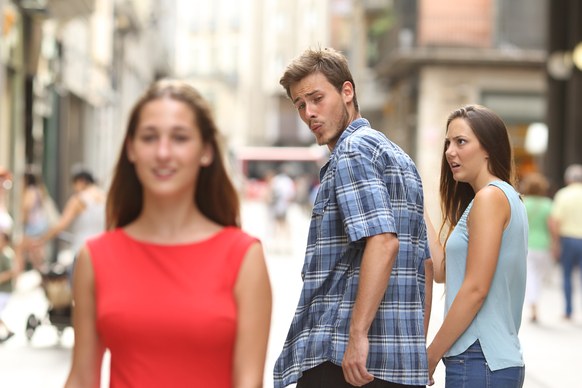All names have been changed to protect the individuals’ privacy.
Quotations have been lightly edited for clarity and expression.
“He didn’t want to say ‘I love you’, didn’t want to call me his girlfriend, didn’t want to call it a relationship. But we were definitely spending every single day together. 24/7. Literally 24/7. I think at some point he was living in my house,” Jade, who is currently 23, says.
“There was a disconnect between our private time and our time outside… he wouldn’t go on dates. We would only hang out around other people.”
To Jade, all of this was puzzling because she shared “very intense feelings” with the man. “We were spending 24/7 together … obviously we were very crazy about each other,” she stresses.
“[But] at any time when I tried to initiate a conversation about turning it into something, it would only emphasise how we were nothing.”
Jade and her man (for lack of a better term) weren’t exactly nothing—they were in a situationship.
Ignore the myriad of websites purporting to diagnose your situationship. If you even have to wonder whether you are in one, well, you are in one.
A what?
The esteemed periodical Cosmopolitan, widely regarded by internet scholars as the first to bless us with this portmanteau, explains:
A situationship … [is] the catch-all term for those relationships sitting at the intersection of “hooking up” and “in a relationship.” It’s a scary precipice, teeter-tottering between “more than hooking up” and “very much dating,” where a simple “what are we” can throw the entire system out of balance.
But Cosmopolitan’s definition is still frustratingly ambiguous to me. It relies on induction rather than deduction to give the situationship existence. It is better at telling us what a situationship is not rather than what a situationship is.
I know that it hovers between two states, but still—what exactly is a ‘situationship’? I want to know what meaty substance lies within its lack.
To answer this question, I turned to the Oxford English Dictionary, a resource that has never failed me. It told me that a ‘situationship’ is a “No dictionary entries found for ‘situationship’.” As always, the OED’s profundity led to insights: I had the epiphany that this is perhaps the most accurate denotation of the term because a situationship is, by definition, undefinable.
With its ambiguity, the situationship can take many forms. Unlike Jade, who wanted to forge something permanent, Lester seems happy to be in his situationship.
Every two weeks or so, Lester, 28, visits a friend’s house—and stays for breakfast the morning after.
But their conversations happen on a daily basis. After every Game of Thrones episode, they vent their frustrations together. Apropos of nothing, they send each other photographs of their meals through the day, through the week. They even plan regular movie outings in advance.
It seems to me—if I’m not being presumptuous—their interactions display all the trappings of a relationship. Yet, both Lester and his friend are active on dating apps.
“We don’t talk about what we are … sometimes I ask him if he’s seeing anyone seriously, and if I am, I’ll tell him.”
Lester did not want to tell me about his feelings for his friend or his reasons for not talking about this absence of labels because “It’s a very private topic leh”—a telling response in itself. Perhaps he really didn’t want to about it, or perhaps he himself didn’t know why and didn’t want to think about it.
Regardless of Jade’s or Lester’s reasons for initiating and remaining in their respective situationships, some characteristics are common: a lack of labels and commitment; an aversion to communicating their feelings; not ever meeting the friends of their ‘partners’; no shared photographs on social media.
Ignore the myriad of websites purporting to diagnose your situationship. If you even have to wonder whether you are in one, well, you are in one.

Associate Professor Norman Li, who conducts research into the psychology of mate preferences at the Singapore Management University, thinks that the growing ambivalence towards romantic commitment today is brought about by technology.
Over an email exchange, Professor Li told me, “People can now encounter [on the internet] up to hundreds if not thousands of potential mates in a single day … Having a huge amount of perceived options and living in a world where societal norms are changing (again, owing to technological change) reduces the desire to commit to any one partner or any traditional, defined relationship arrangement.”
Furthermore, “People still want intimacy, passion, and the experience of emotions, but just that the commitment aspect of relationships is diminished.”
To put it crudely, situationships are more prevalent today because apps like Tinder, Bumble, Grindr, HER, Coffee Meets Bagel, among a plethora of others, promise a fresh bounty of new faces and romantic possibilities every time we launch it. And this sheer range of potential options is afflicting us with an acute state of FOMO. (Even though we’re not really missing out on much: most conversations peter out after the initial charming contact of “hey hey hi hi hey [dick pic] sup? my dick”.)
Because such apps have become the dating default, most of us no longer know of other ways to meet and talk to new people. We don’t know how to human around strangers in the real world anymore, so we are trapped in this digital ecosystem of illusory choice.
This veritable marketplace, in turn, makes us greedy and selfish. We think that happiness lies in the next swipe, despite having, in front of us, a flesh-and-blood person we enjoy spending time with.
Both Jade’s and Lester’s relationships with their ‘partners,’ then, are exemplary situationships. There is passion and emotion, but no commitment.

At the same time, it’s not dating apps in particular that are contributing to the ascent of situationships. Even when removed from a specifically romantic context, people still harbour a sort of predatory instinct towards everyone they see.
Dr Li explains that this is because “our minds have evolved to perceive … [people whom we will not ever meet let alone be interested in us] as real options.”
Take an Instagram model whom we follow because we are fascinated by her photographic performance piece. She is exploring all humanly possible positions her body can contort into in front of a brick wall.
Despite the fact that she hypothetically lives in a lonely brick hut in Saskatchewan, Canada, and thinks that air travel is an offence against nature, our brain is engineered to release neurotransmitters that signal to us that she is a potential mate.
It might sound a little extreme, but simply put: just because we can see her and she inspires emotions in us, we start to think of her as a potential partner—so we decide not to commit to anyone.
And this is just the effect one individual can have on the way we relate to people romantically. One individual—out of the potentially thousands of people most of us typically follow on Instagram and other social media platforms.
As if we weren’t already fallible enough, Dr Li tells me that we are even susceptible to the imaginary charms of “fictitious characters on the internet or television.”
In other words, it’s not just dating apps and social media that are eroding our desire to settle down with a single person. It’s also Margaery Tyrell and Oberyn Martell on Game of Thrones. Both of them. At the same time.
While this is a testament to the power of art and media to conjure alternative realities, it also reveals the sheer stupidity of the human brain.
Dr Li elaborates, “Our minds never acquired the ability to differentiate real people from virtual ones … this inability allows pornography to be entertaining (and addictive), people to think they have better social lives after watching situation comedies (e.g., Friends), and, in the current context, better mating options after seeing attractive people in magazines, television, or the internet.”
All these real and perceived options contribute to such an overwhelming excess that we sometimes get paralysed and are thus unable to make the decision to commit to someone because we are afraid that, in doing so, we might be settling.
While this sounds theoretical in nature—and I don’t quite know anyone who is in a situationship specifically because he or she is pining for an Instagram contortionist or considers Margaery Tyrell his or her future bae—the consequences of our faulty biology are eminently evident.
Just think of how Japanese men have started marrying virtual characters. Or, more mundanely, how people consider liking Instagram posts of attractive individuals a form of cheating.
These behaviours are not directly related to situationships, but nevertheless prove that we are already grappling with the factors that give rise to them. What Professor Li outlines is then not theoretical speculation, but a set of real-world behaviours that might normalise situationships one day.

As far as I know, Lester is still in his situationship. They are watching Dark Phoenix when it opens, even though “I know it’ll suck but I want to see Sansa burst into flames.”
Jade eventually left her situationship.
“The turning point for me,” she says, “Was when … I saw him talking to another girl and I realised he was falling for this other girl. But without a label … it meant that he was fair game to anyone. And I realised that I’m not enjoying this feeling.”
But she didn’t quite see her decision as an expression of her agency or a step towards self-empowerment.
When you are not technically together, “it’s not even a choice whether you want to stay,” she explains. “You have no power to claim that person,” so, in a way, you don’t have the ability to leave him either.
But the power that the situationship exerted over her was tangible: she says that it made her feel like “you’re not good enough and no one wants to claim you.”
Why, she wondered, did she “cling to a person” even though it made her “feel so worthless”?
When Jade said that, causing my chest to feel odd in the process, I realised that situationships are perhaps a modern manifestation of Romeo and Juliet.
Situationships are, most of the time, tragic love affairs in which equal affections cannot be, in which society and individual circumstances conspire to nip in the bud a blossoming romance, to silence declarations of love.
Technology and changing societal norms might be modifying the structure of relationships. But the situationships that arise from these factors do not prove that love is dead. On the contrary, situationships show that our fundamental desire to connect with someone remains untouched.
And, hungry for companionship, we let this desire run rampant. We try to find love while neglecting to consider how modern society has insidiously changed the way we date and chart the paths of our relationships.
It’s not that we don’t want to be in a committed relationship anymore. We’ve just forgotten how to be in one.
Have you been in a situationship before? If you write to us at community@ricemedia.co, we promise we will talk about our feelings together.






